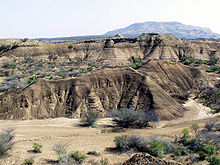Omo Kibish Formation

The Omo Kibish Formation or simply Kibish Formation is a
MSA Lithic assemblage
During Richard Leakey's original 1967 excavations several stone tools were found in association with Omo 1 at Kamoya's hominid site (KHS) but were not well described in the research literature. In the 2000s further excavations occurred at KHS in addition to two other sites: Awoke's hominid site (AHS) also located in Member 1 and the Bird's Nest Site (BNS) located in Member 2. Summaries of the lithic assemblages found during the more recent excavations also consider the lithics found in the initial 1967 excavation.[5]
The most common material used to produce the lithics found is chert. In general high quality fine-grained cryptocrystalline silicate raw materials such as jasper, chert, chalcedony comprise the clear majority (60-90% ) across all sites. Given that all but one rare occurring material could be found in cotemporary gravel deposits in Member 1, it is predicted that early hominins obtained the necessary rock
Faunal remains
Large-mammal fauna
Research by Assefa et al. sampled all members but obtained faunal remains from only Members I, III, and IV. The faunal assemblages obtained from each member are similar in their diversity of mammals and are largely representative of the large mammals which comprise the current community of fauna in the area. That is, predominantly
Fish fauna
Taxonomic Composition
In total, 337 skeletal specimens of fish were collected from the Kibish formation members; as in the case of the mammals, fossils were found only in members I,III and IV. Although some of the 337 specimens likely belonged to the same individuals, it is believed that summaries of the taxonomic frequencies is not greatly impacted by this fact.[7]
Together perciforms and siluriforms (catfish) comprise a staggering 86.7 percent of the Kibish assemblage. Importantly, the order perciform is represented entirely by a single species (Lates niloticus) while 76 percent of siluriforms are represented by Synodontis and clariids. Although the Kibish ichthyofauna does not closely approximate the documented biodiversity of the extant community (9 out of the 37 known genera were identified), overall it is similar to the modern fauna in the region. Member III contained all nine genera while Member I was missing Hydrocynus and Schilbe; nonetheless the two members were similar in the taxonomic frequencies (by order). Member IV contained only the three predominant genera ( Lates, Synodontis and Clarias).[7]
Hominid Interaction
Although there are no suggestive markings on the fossil material itself, other lines of evidence suggest that fishing was an established method of subsistence for hominids occupying the Omo Turkana Basin. The main evidence includes barbed bone points, similar to those in other MSA sites, found in Member IV. In said MSA sites in eastern and southern Africa, these bone points were found in association with processed fish material. Moreover, characteristics of some of the Kibish taxa, such as their large size or preference for open waters habitats suggest that they would indeed require tools to be procured.[7]
